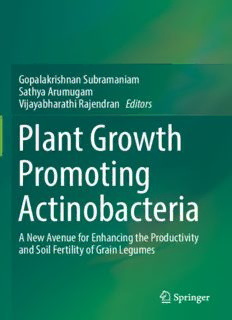
Plant Growth Promoting Actinobacteria: A New Avenue for Enhancing the Productivity and Soil Fertility of Grain Legumes PDF
Preview Plant Growth Promoting Actinobacteria: A New Avenue for Enhancing the Productivity and Soil Fertility of Grain Legumes
Gopalakrishnan Subramaniam Sathya Arumugam Vijayabharathi Rajendran E ditors Plant Growth Promoting Actinobacteria A New Avenue for Enhancing the Productivity and Soil Fertility of Grain Legumes Plant Growth Promoting Actinobacteria ThiSisaFMBlankPage Gopalakrishnan Subramaniam (cid:129) Sathya Arumugam (cid:129) Vijayabharathi Rajendran Editors Plant Growth Promoting Actinobacteria A New Avenue for Enhancing the Productivity and Soil Fertility of Grain Legumes Editors GopalakrishnanSubramaniam SathyaArumugam Bio-Control,GrainLegumes Bio-Control,GrainLegumes ICRISAT,Patancheru,Hyderabad ICRISAT,Patancheru,Hyderabad Telangana,India Telangana,India VijayabharathiRajendran Bio-Control,GrainLegumes ICRISAT,Patancheru,Hyderabad Telangana,India ISBN978-981-10-0705-7 ISBN978-981-10-0707-1(eBook) DOI10.1007/978-981-10-0707-1 LibraryofCongressControlNumber:2016939389 #SpringerScience+BusinessMediaSingapore2016 Thisworkissubjecttocopyright.AllrightsarereservedbythePublisher,whetherthewholeor part of the material is concerned, specifically the rights of translation, reprinting, reuse of illustrations,recitation,broadcasting,reproductiononmicrofilmsorinanyotherphysicalway, andtransmissionorinformationstorageandretrieval,electronicadaptation,computersoftware, orbysimilarordissimilarmethodologynowknownorhereafterdeveloped. Theuseofgeneraldescriptivenames,registerednames,trademarks,servicemarks,etc.inthis publicationdoesnotimply,evenintheabsenceofaspecificstatement,thatsuchnamesare exemptfromtherelevantprotectivelawsandregulationsandthereforefreeforgeneraluse. Thepublisher,theauthorsandtheeditorsaresafetoassumethattheadviceandinformationin thisbookarebelievedtobetrueandaccurateatthedateofpublication.Neitherthepublishernor the authors or the editors give a warranty, express or implied, with respect to the material containedhereinorforanyerrorsoromissionsthatmayhavebeenmade. Printedonacid-freepaper ThisSpringerimprintispublishedbySpringerNature TheregisteredcompanyisSpringerScience+BusinessMediaSingaporePteLtd. We dedicate this book to Dr Om Prakash Rupela (1948–2015), Ex Principal Scientist (Microbiology), ICRISAT Patancheru, Telangana, India, who mentored and encouraged us to work toward biological options for agriculture. ThiSisaFMBlankPage Foreword The year 2016 is a special one for pulses. The United Nations announced 2016asthe “InternationalYear ofPulses (2016 IYOP)” inorder toempha- size the need to focus on pulses as critical components for global food and nutritional security and to create awareness and understanding of the challengesfacedinpulsefarmingandvaluechains.Pulses,orgrainlegume crops, are often referred to as “poor man’s meat,” as they offer a cost- effective alternative to animal proteins. Besides protein, their richness in micronutrients andothervitalelementsmakepulsescriticalentitiesinfood andfeedvaluechainsaroundtheworld. As with all crops, pulse production is hindered by biotic and abiotic constraints, including pest and pathogen attacks, infertile soils, and climate variability and change. Improved cultivars and management practices are continuing and required outputs from research to ensure that crops are productive and profitable and their grains provide nutritious and healthy food. Production practices must also address the risks associated with the useofpesticidesandfertilizersandmustexplorealternateoptions,especially biologicalresources,forenhancingtheproductionofpulses. Inthecontextofbiologicaloptions,plantgrowth-promoting(PGP)bacte- ria, actinobacteria in particular, are well known for their usefulness in crop productionandprotectionandinmaintainingsoilhealth.Actinobacteriaare commonlyfoundinsoil,compost,freshandmarinewater,anddecomposing organic materials, and they produce secondary metabolites of agricultural importance.Suchmetabolitesholdfungicidal,bactericidal,insecticidal,and plant growth-promoting traits and can fill the need for biological agents. Exploration of such potential PGP actinobacteria offers the prospect of alternative chemical crop protectionagentsand soimprovedenvironmental healthandsustainability. I commend the editors, Gopalakrishnan Subramaniam, Sathya Arumugam, and Vijayabharathi Rajendran of the book Plant Growth- Promoting Actinobacteria: A New Avenue for Enhancing the Productivity and Soil Fertility of Grain Legumes. They have the expertise in basic research, crop production, and plant protection with reference to the use of PGP actinomycetes from the laboratory to field levels. This book contains 19 chapters reporting on the combination of grain legumes with actinomycetes, with details starting from the diversity of actinomycetes vii viii Foreword throughthecommercializationofPGPactinomycetesandtheirmetabolites. Eachchapterisstandaloneandcontributestothefield. This book is a strong contribution to supporting pulses in food and feed systemsglobally.Itcriticallyassessesthedataandoffersstudyonpractical aspectsoffieldapplications.Istronglyendorsethisbookasitmakesalasting contributiontothefieldofplantgrowth-promotingactinomycetesandforits contributiontosustainableagriculturearoundtheglobe. DeputyDirectorGeneral-Research PeterCarberry InternationalCropsResearchInstituteforthe Semi-AridTropics,Patancheru, Hyderabad,India January21,2016 Preface Grain legumes are the abundantly used plant protein source mainly in developing countries of South East Asia, Africa, and Latin America. They areacost-effectiveoptionforanimalproteinsincludingfish,meat,anddairy products and hence attained the name “poor man’s meat.” Besides the protein, their richness in micronutrients and other vital elements made them essential entities in food and feed. Their unique association with rhizobia contributes 65 % of nitrogen necessity in agriculture through the processofsymbioticnitrogenfixation.Theirbetteradaptionasintercropwith cereals or tuber crops helps in income generation and livelihood resilience. Cultivationofgrainlegumesbenefitssmallholderfamiliessincetheyarethe primarycultivatorsofthesecrops,especiallythewomensincetheirpartici- pationinvaluechainpavesawayforcombatingnutritionaldeficienciesand improvingthewell-beingoftheirchildren. Constraints related to the production of legumes are pest and pathogen attacks, unstable yield, poor adaptation, and climate changes. Besides this, the increasing per capitaconsumptionofgrain legumes bylow-incomeand developingcountriesmadeagapbetweengrainlegumesupplyanddemand. In case of chickpea, groundnut, and pigeonpea, the current shortfall of 7 million tons of supply in low-income food-deficit countries is projected to increase by almost 50 % by 2020, if the same production system continues. The productivity of grain legumes is stagnant for the last two to three decades in spite of using the best breeding and molecular techniques. Further, the increasing costs associated with the improved cultivars and negative effects associated with pesticides and fertilizer use necessitate alternateoptions.TheUnitedNationsalsoemphasizedtheneedforfocusing on grain legumes by announcing year 2016 as the International Year of Pulses (2016 IYOP), in order to create awareness and understanding of the challengesfacedbypulsefarmers. Rhizospheric soil, inhabited and influenced by the plant roots, is usually richinnutrientswhencomparedtothebulksoil,duetotheaccumulationof numerousaminoacids,fattyacids,nucleotides,organicacids,phenols,plant growth regulators/promoters, putrescine, sterols, sugars, and vitamins releasedfromtherootsbyexudation,secretion,anddeposition.Thisresults in enrichment of microorganisms (10–100-folds than the bulk soil) such as bacteria, fungus,algae,andprotozoa,amongwhich bacteriainfluenceplant ix
Description: